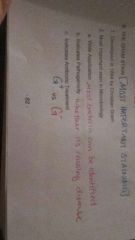![]()
![]()
![]()
Use LEFT and RIGHT arrow keys to navigate between flashcards;
Use UP and DOWN arrow keys to flip the card;
H to show hint;
A reads text to speech;
42 Cards in this Set
- Front
- Back
- 3rd side (hint)
|
Pathway of light |
Light source Substage Assembly Specimen Objective lens (1st mag)=real image Barrel Ocular lens (2nd mag) =virtual image |
|
|
|
Objective Lenses |
Scanning lens Low dry lens High dry lens Oil immersion lens |
|
|
|
Scanning lens |
Red 4 x |
|
|
|
Low dry lens |
Yellow 10 x |
|
|
|
High dry lens |
Blue 40 x |
|
|
|
Oil immersion lens |
White 100 x |
|
|
|
Magnification |
Ocular power X objective power |
|
|
|
Resolution |
R= wavelength / numerical aperture (2) |
|
|
|
Parafocalization |
Slowly making your way from corse to fine focusing |
|
|
|
Animal like group |
Protozoa Heterotrophic (eats things) Eucaryotes (has a nucleus) |
|
|
|
Sarcadonia |
Pseudopodia Soft body, slide around by extending cell membrane |
Amoeba proteus (white blood cells) |
|
|
Mastigophora |
Flagella |
Trypanosoma lewisi (sleeping sickness) |
|
|
Ciliophora |
Ciliates (cilia) |
Paramecium caudatum |
|
|
Sporazoa |
Nonmotile (no appendage) |
Plasmodium (causes malaria) |
|
|
Plant like groups |
Have a cell wall Cyanobacteria Algae Fungi Bacteria |
What do they have |
|
|
Cyanobacteria |
Autotrophic/Procaryotes Dont eat things and no nucleus |
Anabaena |
|
|
Algae |
Autotrophic/Eucaryotes Dont eat but have a nucleus |
Spirogyra |
|
|
Fungi |
Heterotrophic/Eucaryotes Eat and have a nucleus |
Rhizopus (bread molds) |
|
|
Bacteria |
Heterotrophic/Procaryotes Eat but no nucleus |
|
|
|
Standard Shape of Bacteria |
Bacilli- rods (70%) 50% have flagella [ex: e.coli] Cocci - spheres (25%) few are motile [Staph groups, Strep chains] Spirilla-spirals (5%) most are motile [ex: lyme, syphilis] |
|
|
|
Special shapes of bacteria |
Coccobacilli- ovals [ex: yersinia-plague] Vibrios- commas [ex: cholera] Pleomorphic- many shapes, soft bacteria, take on pressure of surroundings [ex: mycoplasma] |
|
|
|
Live preps |
Wet mount Hanging drop |
|
|
|
Brownian motion |
False motility- jiggling around water molecules colliding with smal bacteria |
|
|
|
Microbial media |
Any substance for the growth of Microorganisms |
|
|
|
Types of Media |
Solid- Agar Liquid-Broth |
|
|
|
Agars |
Slants-slope Deeps-plugs Plate media(always an agar) Petri standard 100x15mm |
|
|
|
Media Stats Agar |
Solidifies at 42°C Liquifies at 100°C Used at 1.5% concentration (algae) Nondigestable =stays solid |
Gelatin is used at 12-15% concentration and is digestable Liquifies at 25°C |
|
|
Microbial Culture |
Aseptic Technique Prevent contamination (Robert Koch) Flame wire Remove tube caps and flame tubes Inoculate Flame tubes and replace caps Flame wire |
Technique |
|
|
Broth observations |
Pellicle Surface growth Turbidity Cloudiness Sediment Bottom of tube Slime Floaty material |
|
|
|
Slant observations |
Pigment Color Patterns |
|
|
|
Pure culture techniques |
Only one type of microorganisms |
|
|
|
Streak plates methods |
Continuous First half done toward you second half away from you(second half has best stuff) Quadrant (best) cool spot, flame wire after eat time Radiant Sunlike, turn, then do it again |
|
|
|
Pour plate methods (x^3) |
Always works better, gives better isolation May be better but streak plates are easier Pour Wipe Flame Pour Circle |
|
|
|
Staining techniques |
Simple stain Uses one dye Differential stain Structural stain |
|
|
|
Simple stain (shape, grouping, and size) |
Types of dyes Basic [cationic] positive charge Cv, mb, cf Acidic [anionic] negative charge Eosin Indifferent- no charge Nigrosin (india ink) used to look at CSF Stains around the cell |
|
|
|
Difderential stain |
Uses more than one dye Differentiates cells based on color, due to biochemical differences |
|
|
|
Acid fast stain |
Differentiates the MYCOBACTERIA (toughest active bacteria) Has a dense waxy PG Cause important human diseases, TB Leprosy |
|
|
|
Acid fast stain continued |
Steps Initial stain with carbol fuchsin (red dye) Wash with hydrochloric acid Counterstain with Methylene Blue RED in an OIF =acid fast Bacilli positive |
|
|
|
Acid fast stain methods |
Ziehl Neelsen (heat) speed it up with heat, can cause false negative Kinyoun (cool) no heat |
|
|
|
The GRAM stain |

|
G+ vs G- |
|
|
GRAM stain Methods and steps |

|
|
|
|
Epithelial cells |
Should be Pink |
|

